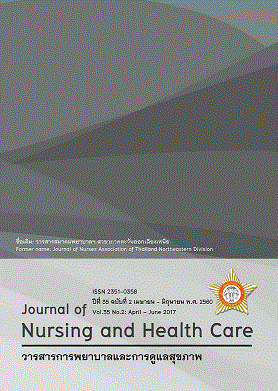ผลของโปรแกรมป้องกันการหกล้มแบบสหปัจจัย ต่อพฤติกรรมการป้องกันการหกล้ม ของผู้สูงอายุในชุมชน The Effectห of Multifactorial Fall Prevention Program on Fall Prevention Behavior among Community - Dwelling Older Adults
คำสำคัญ:
ผู้สูงอายุ การหกล้ม พฤติกรรมป้องกันการหกล้ม โปรแกรมป้องกันการหกล้มแบบสหปัจจัย older adults, fall, fall prevention behavior multifactorial, fall prevention programบทคัดย่อ
บทคัดย่อ
การวิจัยครั้งนี้เป็นการวิจัยแบบกึ่งทดลอง เพื่อศึกษาผลของโปรแกรมป้องกันการหกล้มแบบสหปัจจัย ต่อพฤติกรรมการป้องกันการหกล้มของผู้สูงอายุในชุมชน กลุ่มตัวอย่าง คือ ผู้สูงอายุเพศหญิงและเพศชาย ที่อาศัยอยู่บ้านเป็ด ตำบลบ้านเป็ด อำเภอเมือง จังหวัดขอนแก่น อายุระหว่าง 60 - 75 ปี จำนวนทั้งสิ้น 60 คน แบ่งเป็นกลุ่มทดลอง 30 คน กลุ่มควบคุม 30 คน เครื่องมือที่ใช้ในการวิจัย ประกอบด้วย แบบสัมภาษณ์ข้อมูลส่วนบุคคล แบบประเมินความสามารถในการปฏิบัติกิจวัตรประจำวัน แบบประเมินสภาพสมองเบื้องต้น แบบประเมินความเสี่ยงต่อการหกล้มของผู้สูงอายุไทยในชุมชน แบบประเมินความปลอดภัยของสิ่งแวดล้อมภายในบ้านและภายนอกบ้าน แบบสัมภาษณ์พฤติกรรมการป้องกันการหกล้ม และโปรแกรมป้องกันการหกล้มแบบสหปัจจัย วิเคราะห์ข้อมูลโดยใช้สถิติเชิงพรรณนา chi-square test และ independent t-test
ผลการวิจัย เมื่อเปรียบเทียบคะแนนพฤติกรรมการป้องกันการหกล้มภายหลังการทดลอง พบว่า คะแนนพฤติกรรมการป้องกันการหกล้มของผู้สูงอายุในชุมชนกลุ่มทดลอง มากกว่ากลุ่มควบคุมอย่างมีนัยสำคัญทางสถิติ (p < .001) (t = - 30.29, p = .000) การศึกษานี้แสดงให้เห็นว่าโปรแกรมป้องกันการหกล้มแบบสหปัจจัยของผู้สูงอายุในชุมชน โดยการแจกคะแนนความเสี่ยงต่อการหกล้มเพื่อกระตุ้นให้ผู้สูงอายุได้ตระหนักถึงความเสี่ยงในการหกล้มของตนเอง การให้ความรู้เพื่อป้องกันการหกล้ม การออกกำลังกายด้วยตาราง 9 ช่อง การแจกคู่มือป้องกันการหกล้ม การแจกปฏิทินเตือนการหกล้ม การติดตามเยี่ยมบ้านเพื่อปรับสิ่งแวดล้อมให้ปลอดภัยและการตรวจสอบการรับประทานยา ส่งผลทำให้ผู้สูงอายุที่เข้าร่วมโปรแกรมมีพฤติกรรมการป้องกันการหกล้มสูงขึ้น ดังนั้นจึงควรส่งเสริมให้มีการนำโปรแกรมไปใช้อย่างต่อเนื่อง
Abstract
The quasi-experimental research aimed to investigate the effects of a multifactorial fall prevention program on fall prevention behavior among community-dwelling older adults. The study sample consisted of 60 older adults aged between 60 and 75 years old who lived in Tambon Baan Ped, Muang District, Khon Khaen Province, with 30 of them being assigned into the experimental group and the other 30 into the control group. The instruments used in this study were composed of the Barthel ADL Index, the Mini-Mental State Examination (MMSE) (Thai version), the demographic characteristics interview protocol, the Thai-FRAT questionnaire, the safety assessment of internal and external home environment questionnaire, the fall prevention behavior interview protocol, and the multifactorial fall prevention program. Data were analyzed by means of descriptive statistics, chi-square test, and independent t-test.
The study findings when compared to the post-test mean scores of the subjects in both groups, it was seen that the mean score of the subjects in the experimental group was higher than that of the subjects in the control group with statistical significance (p < .001) (t = -30.29, p = .000). The present study revealed that the multifactorial fall prevention program for community-dwelling older adults with distributing scores on risks of falls to raise older adults’ awareness of their own risks of falls, disseminating knowledge on fall prevention, exercising with the nine-slot table, distributing the manual on fall prevention, distributing the fall reminder calendar, paying home visits to offering advice on modification of the environment to ensure safety and examining medication intake were effective to increase fall prevention behavior among older adults. Therefore, it should be promoted for continuous use to prevent falls among older adults in the community



